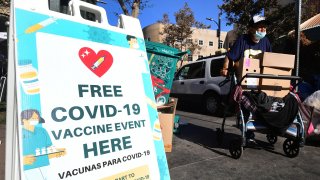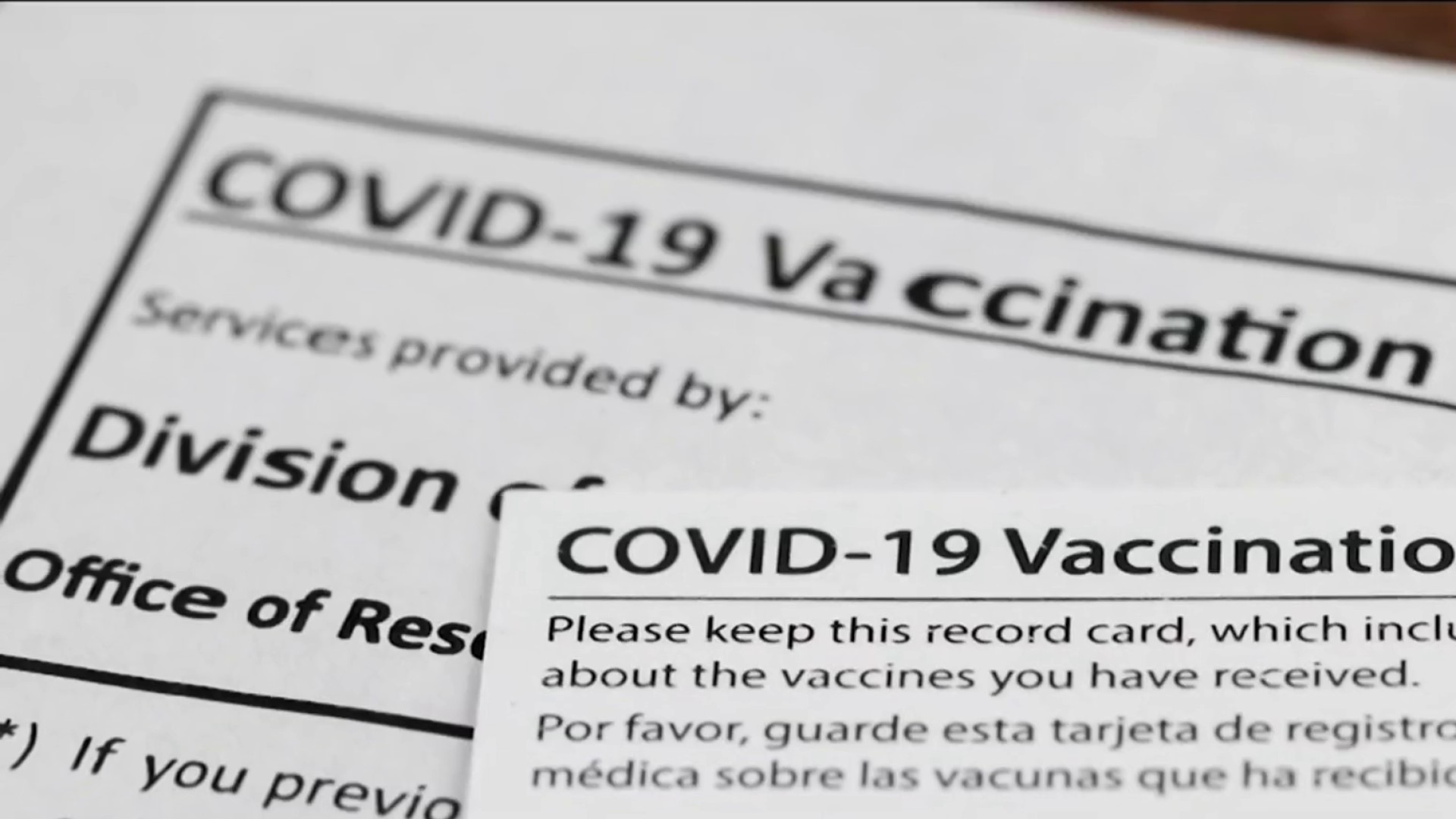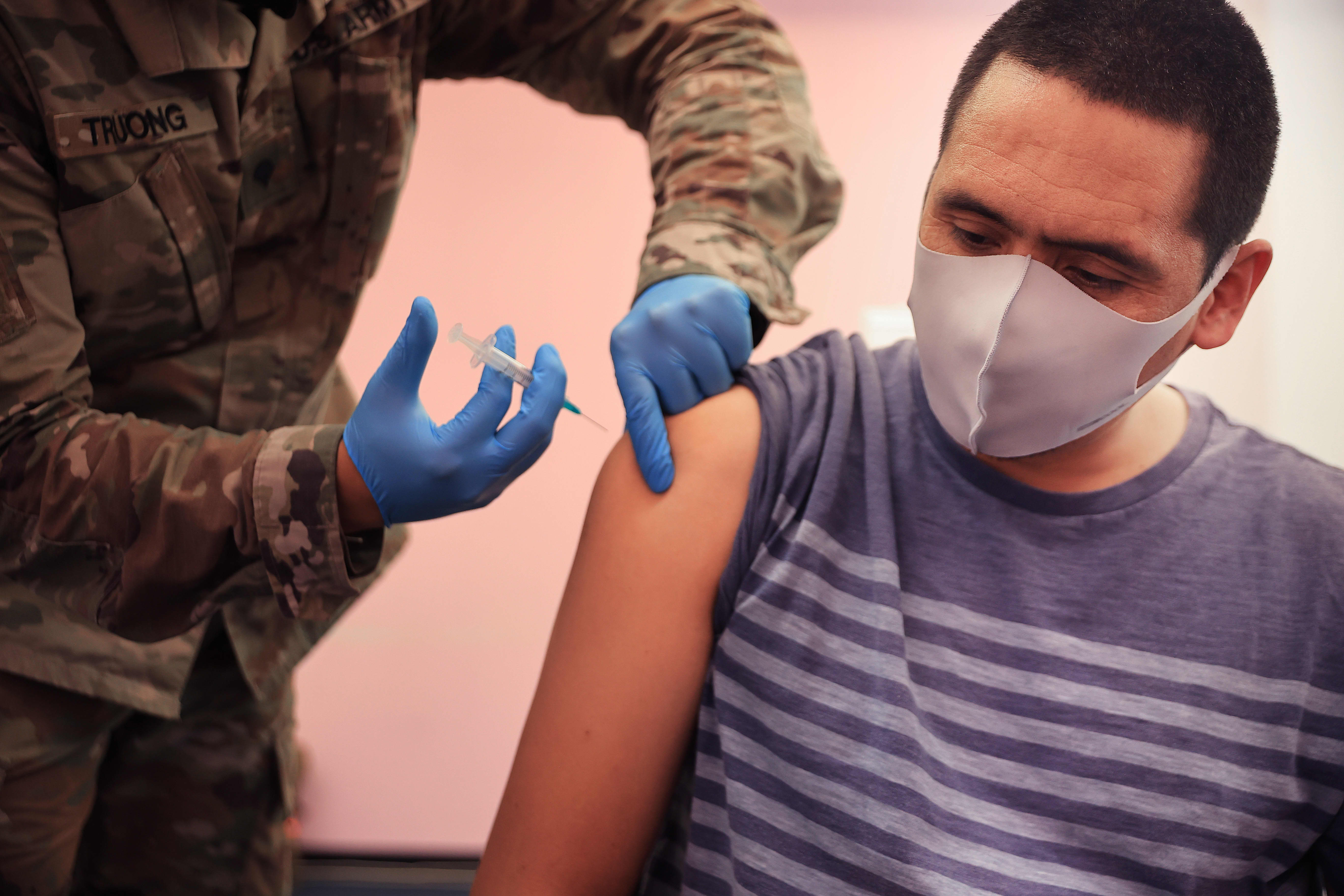
A man pushes his belongings past a sign announcing a free Covid-19 vaccination clinic for homeless people in Los Angeles, California on September 22, 2021, hosted by the Los Angeles County Department of Public Health and United Way. – Covid-related hospitalizations across Los Angeles County fell below 1,000 for the first time since late-July as a steady decline continues from a mid-August peak of nearly 1,800. (Photo by Frederic J. BROWN / AFP) (Photo by FREDERIC J. BROWN/AFP via Getty Images)
What to Know
- The government's VAERS website is a place where anyone can report potential side effects from a vaccine.
- It is intended to help detect new or rare side effects, monitor increased instances and help to identify risk factors.
- Information may be incomplete, inaccurate, coincidental or unverifiable, since it is self-reported.
Americans opposed to the COVID-19 vaccines are focusing attention on a federal website dedicated to possible side effects, using it to sometimes falsely insist that the vaccines have killed thousands of people.
The Vaccine Adverse Event Reporting System is exactly that, a place to report side effects from the COVID-19 vaccine and others. Anyone can do it.
Managed by the Centers for Disease Control and Prevention and the U.S. Food and Drug Administration, it is meant to help detect new or rare side effects, monitor increased instances and help to identify risk factors.
Get top local stories in Connecticut delivered to you every morning. Sign up for NBC Connecticut's News Headlines newsletter.
What it is not intended to do: determine whether a vaccine caused a health problem, according to the VAERS website. Information may be incomplete, inaccurate, coincidental or unverifiable, since it is self-reported.
“VAERS is a passive reporting system, which anybody can report to, which means there is no checking,” said Dr. Kawsar R. Talaat, the co-director for clinical research at the Institute for Vaccine Safety at the Johns Hopkins Bloomberg School of Public Health.
“So you could have somebody with serious heart disease who’s had a bunch of different procedures recently who gets the vaccine and three weeks later dies of a heart attack,” she said. “But if they’re frail or have had serious heart disease there is no way to link that vaccine to the heart attack unless you do a population-wide study and that is not what VAERS is.”
VAERS was created in 1990 as a national early warning system about possible problems posed by U.S.-licensed vaccines, according to its website. It can detect unusual or unexpected patterns of reactions that might indicate a possible problem with a vaccine so that the CDC and FDA can do additional work and evaluation.
Reports of adverse events to VAERS following vaccination, including deaths, do not necessarily mean that a vaccine caused a health problem
VAERS site disclaimer from the CDC
Since the pandemic began, there have been 719,546 deaths in the United States attributed to COVID, as reported as of Oct. 14 by the Johns Hopkins University COVID tracker. As of Oct. 13, 404.3 million doses of a COVID-19 vaccine have been administered, with 187.9 million people fully vaccinated, according to the CDC.
The CDC notes on the website which serious adverse reactions it is following closely for COVID-19, including the reports of 8,390 deaths from Dec. 14, 2020, through Oct. 4, when more than 396 million doses of the COVID vaccine were administered in the United States.
The FDA requires that healthcare providers report all deaths after a COVID vaccine regardless of whether there is a clear connection.
“Reports of adverse events to VAERS following vaccination, including deaths, do not necessarily mean that a vaccine caused a health problem,” the CDC says in bold type on its website.
And it notes that a review of death certificates, autopsy and medical records has not established a causal link to COVID vaccines. The reports are rare and amount to 0.0021% of those who were vaccinated.
More COVID Vaccine News
The CDC does caution about what it calls a “plausible causal relationship” between the Johnson & Johnson Janssen vaccine and thrombosis with thrombocytopenia syndrome, blood clots with low platelets. It is also rare and serious and has caused deaths. Women 18 to 49 years old are particularly at risk.
The CDC and the FDA recommended pausing the use of the Johnson & Johnson in April but the government’s Advisory Committee on Immunization Practices decided about a week later that its benefits outweighed the risks with a new warning for women.
Three other reactions the CDC is monitoring:
Guillain-Barre Syndrome, a rare disorder in which a person’s immune system damages nerve cells leading to muscle weakness and sometimes paralysis, but most people recover fully. The reaction is also connected to the Johnson & Johnson vaccines though CDC notes that among 14.9 million doses administered, 219 preliminary reports of Guillain-Barre syndrome have been identified through Sept. 29. They have mostly been reported about two weeks after vaccination, mostly by men, many 50 years old and older.
Anaphylaxis, a severe allergic reaction which has occurred in between 2 to 5 million and which healthcare providers can treat immediately.
Myocarditis and pericarditis, both of which are also rare. As of Sept. 29, 1,590 reports of either in people 30 and younger have been posted to VAERS, 906 of which have been confirmed. Most involve mRNA vaccinations — Pfizer BioNTech or Moderna — and young men. CDC and others are investigating to determine whether there is a the relationship to vaccination.
Talaat said that reports to VAERS can turn medical investigators to other systems for collecting data on vaccine reactions, including the Vaccine Safety Datalink. That is a population-wide system based on insurance claims and information from large health maintenance organizations that is more accurate and allows for controls.
“The (Vaccine Safety Datalink) helps us … to develop whether there’s an actual association between what is seen and the vaccine,” she said. “It’s still not completely causal but it’s better at associations.”
NBC has received emails citing the VAERS reports, particularly of the deaths. Many included the number of reports received worldwide, which is more than 15,000, and some refer to a separate website that purports to allow easier searches of the VAERS data and which features only a small link to the CDC disclaimers about the information. That website does not say who operates it though it is registered at an address in Toronto, and an email seeking more information was answered with a form reply.
The CDC continues to say that the vaccines are safe and effective.
“They are not causing large numbers of deaths, because if that were true we would have seen it in our other safety monitoring systems, which we’re not seeing,” Tallat said.
“The scrutiny is unprecedented,” Talaat said.




